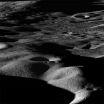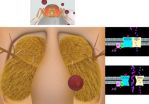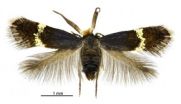(Press-News.org) Electrically charged lunar dust near shadowed craters can get lofted above the surface and jump over the shadowed region, bouncing back and forth between sunlit areas on opposite sides, according to new calculations by NASA scientists.
The research is being led by Michael Collier at NASA's Goddard Space Flight Center, Greenbelt, Md., as part of the Dynamic Response of the Environment At the Moon (DREAM) team in partnership with the NASA Lunar Science Institute (NLSI), managed at NASA's Ames Research Center, Moffett Field, Calif.
"The motion of an individual dust particle is like a pendulum or a swing," says Collier. "We predict dust can swarm like bees around a hive over partially shaded regions on the moon and other airless objects in the solar system, such as asteroids. We found that this is a new class of dust motion. It does not escape to space or bounce long distances as predicted by others, but instead stays locally trapped, executing oscillations over a shaded region of 1 to 10 meters (yards) in size. These other trajectories are possible, but we now show a third new motion that is possible." Collier is lead author of a paper on this research published October 2012 in Advances in Space Research.
This effect should be especially prominent during dusk and dawn, according to the team, as regions become partially illuminated while features like mountains and crater rims cast long shadows.
"The dust is an indicator of unusual surface electric fields," says William Farrell of NASA Goddard, a co-author on the paper and lead of the NLSI DREAM team. "In these shaded regions, the surface is negatively charged compared to the sunlit regions. This creates a locally complex, larger electric field with separate positively and negatively charged regions, called a dipole field, over the shaded region. The dust performed its swinging motion under the influence of this dipole. Such a surface process occurring on the moon at the line where night transitions to day, called the terminator, might also occur at small bodies like asteroids. It might be a fundamental process occurring at airless rocky bodies."
There is evidence that dust actually moves this way over the lunar surface. "There are hints for this type of dust swarm in Surveyor images. A twilight was observed over the landed platforms during dusk and dawn. This was surprising at first because the moon does not have a dense enough atmosphere to scatter light when the sun is below the horizon. It was long considered to be light scattered from lifted dust. This model suggests the dust is really leaping or swarming overtop a large number of shaded regions that would exist along the lunar dusk/dawn line, called the lunar terminator. It's a natural fit. Charged lunar dust transport is also believed responsible for the Apollo 17 Lunar Ejecta and Meteorites (LEAM) experiment's observation of highly charged dust near the terminator," adds Collier.
To our eyes, the moon has no apparent activity and seems dead. However, because it has almost no atmosphere, the moon is exposed to the solar wind, a thin stream of electrically conducting gas called plasma blown off the surface of the sun at around a million miles per hour. The effects of sunlight and the solar wind generate a bustle of unseen commotion at the moon. On the day-lit side, sunlight knocks negatively charged electrons off the surface, giving it a positive charge. On the night side or in shadow, electrons from the solar wind rush in, giving the surface a negative charge.
The exact mechanism for launching lunar dust is not uniquely known. Micro-meteoroid impacts can transfer energy to the surface to launch particulates. Also, a rough surface has small, localized concentrations of electric fields that could lift dust electrostatically from the surface. The pendulum motion then happens because sunlit areas on the moon tend to get positively charged, while shaded areas become negatively charged. Since like charges repel each other, a positively charged dust grain in a sunlit area gets pushed away from the positively charged surface. If there were no negatively charged area nearby, the dust grain would rise straight up. However, since opposite charges attract, the positively charged dust gets pulled toward the negatively charged crater floor, bending its path over the crater. Dust launched from the sunlit area with just the right speed will pass over the shaded floor of the crater to the sunlit area on the other side, where the positively charged surface there will reflect it back over the crater again. When many particles do this, the model predicts there should be a swarm or canopy of dust over the crater.
If there were no complications, the particle could continue to bounce between sunlit areas on opposite sides of the crater indefinitely. However, in reality, things like differences in crater rim height, roughness on the crater floor, and interference from the solar wind that weakens the electric field produced by the surface charges can alter the particle's path. These perturbations cause the dust to eventually either fall into the crater or be launched away. "This model provides a natural explanation for the observation of dust ponds inside craters on the asteroid Eros," says Collier.
"Calculating how these complications will affect the path of a dust particle on the moon and around asteroids are good areas for future research," says Collier. "Additionally, we're not sure how many particles get charged and move like this – is it something like one in a thousand, one in a million, or one in a billion? We'd like to do more studies to see how likely it is that a particle will behave this way. Since most of the lunar surface is covered in dust, even one in a billion would still be significant." The team is also planning on examining Apollo-era images to evaluate possible evidence for dust canopies over shadowed craters.
INFORMATION:
The team includes Collier, Farrell, and Timothy Stubbs, also at NASA Goddard. The research was funded by the NLSI.
For more information about the DREAM team visit:
http://ssed.gsfc.nasa.gov/dream/
NLSI is a virtual organization funded by NASA's Science Mission Directorate and the Human Exploration Office in Washington, which enables collaborative, interdisciplinary research in support of NASA lunar science programs. The institute uses technology to bring scientists together from around the world and is comprised of competitively selected U.S. teams and several international partners.
For more information about the NLSI, visit:
http://lunarscience.nasa.gov
NASA sees leaping lunar dust
2013-03-18
ELSE PRESS RELEASES FROM THIS DATE:
Earth's interior cycles contributor to long-term sea-level & climate change, scientists conclude
2013-03-18
Ancient rises in sea levels and global warming are partially attributable to cyclical activity below the earth's surface, researchers from New York University and Ottawa's Carleton University have concluded in an analysis of geological studies.
However, the article's authors, NYU's Michael Rampino and Carleton University's Andreas Prokoph, note that changes spurred by the earth's interior are gradual, taking place in periods ranging from 60 million to 140 million years—far less rapidly than those brought on by human activity.
Their analysis appears in Eos, a newspaper ...
Transistor in the fly antenna
2013-03-18
This press release is available in German.
Highly developed antennae containing different types of olfactory receptors allow insects to use minute amounts of odors for orientation towards resources like food, oviposition sites or mates. Scientists at the Max Planck Institute for Chemical Ecology in Jena, Germany, have now used mutant flies and for the first time provided experimental proof that the extremely sensitive olfactory system of fruit flies − they are able to detect a few thousand odor molecules per milliliter of air, whereas humans need hundreds of millions ...
Tiny minotaurs and mini-Casanovas: Ancient pigmy moths reveal secrets of their diversity
2013-03-18
Researchers Robert Hoare (Landcare Research, New Zealand) and Erik van Nieukerken (Naturalis Biodiversity Center, Netherlands) have named new moths after the Minotaur of Greek mythology and the legendary Italian philanderer Giacomo Casanova in a study of the evolution of southern pigmy moths. The study was published in the open access journal ZooKeys.
The tiny moths, with wingspans of 3 to 8 millimetres, belong to a very old group (the family Nepticulidae), which dates back more than 110 million years to the time of the dinosaurs. Australian pigmy moths are particularly ...
Blood levels of fat cell hormone may predict severity of migraines
2013-03-18
In a small, preliminary study of regular migraine sufferers, scientists have found that measuring a fat-derived protein called adiponectin (ADP) before and after migraine treatment can accurately reveal which headache victims felt pain relief.
A report on the study of people experiencing two to 12 migraine headaches per month, led by researchers at Johns Hopkins, is published in the March issue of the journal Headache.
"This study takes the first steps in identifying a potential biomarker for migraine that predicts treatment response and, we hope, can one day be used ...
Study shows rising rate of propofol abuse by health care professionals
2013-03-18
Philadelphia, Pa. (March 18, 2013) – Abuse of the anesthesia drug propofol is a "rapidly progressive form of substance dependence" that is being more commonly seen among health care professionals, reports a study in the April Journal of Addiction Medicine, the official journal of the American Society of Addiction Medicine. The journal is published by Lippincott Williams & Wilkins, a part of Wolters Kluwer Health.
"Propofol addiction is a virulent and debilitating form of substance dependence" with a "rapid downhill course," write Drs Paul Earley and Torin Finver of ...
Suggestions for a middle ground between unlogged forest and intensively managed lands
2013-03-18
It is increasingly recognized that protected areas alone are not sufficient for successful biodiversity conservation, and that management of production areas (e.g. forestry and agricultural land) plays a crucial role in that respect. Retention forestry and agroforestry are two land management systems aiming to reconcile the production of human goods with biodiversity conservation.
The retention forestry model is, as the name suggests, based on retaining some of the local forest structures when harvesting trees in an attempt to preserve local biodiversity. Agroforestry ...
Can online chat rooms and 'cyberhugs' help chronic pain sufferers cope?
2013-03-18
New Rochelle, NY, March 18, 2013—The more than 100 million Americans living with chronic pain and daily suffering often have limited outlets to talk about their conditions with others who can understand and offer comfort. Online chatrooms may provide a beneficial forum where chronic pain sufferers can openly and safely communicate, as discussed in an article in Cyberpsychology, Behavior, and Social Networking, a peer-reviewed journal from Mary Ann Liebert, Inc., publishers. The article is available free online on the Cyberpsychology, Behavior, and Social Networking website. ...
Chemical trickery explored to help contain potato pest
2013-03-18
This press release is available in Spanish.
The pale cyst nematode, Globodera pallida, is one bad roundworm.
Unchecked, the pest burrows into potato roots to feed, obstructing nutrients and causing stunted growth, wilted leaves and other symptoms that can eventually kill the plant. Severe infestations can cause tuber yield losses of up to 80 percent.
Now, however, U.S. Department of Agriculture (USDA) and cooperating scientists are evaluating new ways to control G. pallida using naturally occurring chemicals called egg-hatching factors.
According to lead scientist ...
9 new wasp species of the genus Paramblynotus described from Africa and Madagascar
2013-03-18
A newly published article "Revision of the Afrotropical Mayrellinae (Cynipoidea, Liopteridae), with the first record of Paramblynotus from Madagascar" by Dr. Simon van Noort, from Natural History Department, Iziko South African Museum, and Dr. Matthew L. Buffington from the Systematic Entomology Lab, USDA offers the description of 9 remarkable new species of wasps. Mayrellinids are extremely rare wasps, which are under-represented in museum collections. Most species are known from single specimens. The study was published in the open access Journal of Hymenoptera Research.
The ...
Only one-third of parents follow doctors' orders for kids all of the time
2013-03-18
ANN ARBOR, Mich. – Pediatricians regularly dispense advice to parents of young children during well-child visits, but a new University of Michigan poll shows that many aren't following doctors' orders.
Only one-third of parents (31 percent) said they follow advice from their child's health care provider all of the time, according to the most recent University of Michigan Mott Children's Hospital National Poll on Children's Health. Thirteen percent said they follow the provider's advice only occasionally.
Parents from lower-income households ( END ...




